Discover 20 hidden attractions, cool sights, and unusual things to do in Chapel Hill (United States). Don't miss out on these must-see attractions: Chapel Hill Museum, Unsung Founders Memorial, and Franklin Street. Also, be sure to include Dean Smith Center in your itinerary.
Below, you can find the list of the most amazing places you should visit in Chapel Hill (North Carolina).
Table of Contents
Chapel Hill Museum
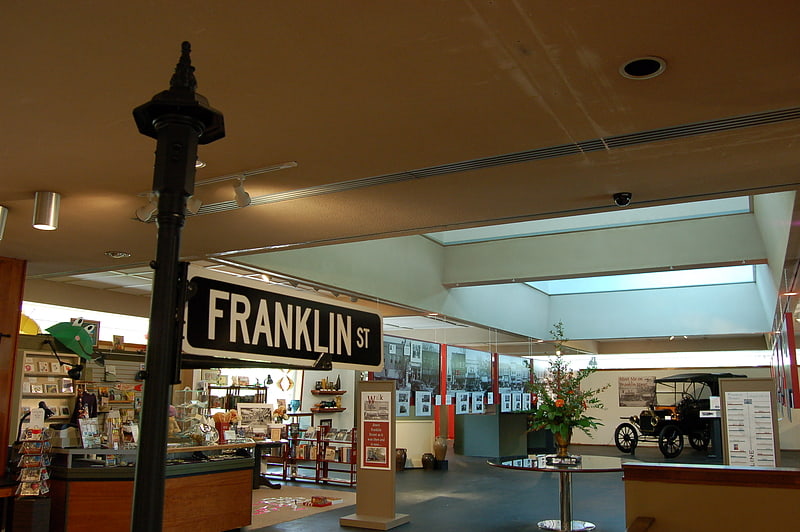
Culture. Chapel Hill Museum was a local cultural and historical museum in Chapel Hill, North Carolina. The museum was founded in 1996 by leaders of the Town of Chapel Hill's Bicentennial Committee and celebrated its 10th anniversary in 2006. In the decade since its founding, Chapel Hill Museum averaged over 20,000 visitors a year and provided education programs to over 3,500 local students a year. The museum closed on July 11, 2010.[1]
Unsung Founders Memorial

Sculpture in Chapel Hill, North Carolina. The Unsung Founders Memorial at the University of North Carolina at Chapel Hill is a memorial located in McCorkle Place, one of the University's quads. It consists of a black granite tabletop supported by 300 bronze figurines and surrounded by 5 black stone seats. The inscription around the edge of the table reads:
The Class Of 2002 Honors The University's Unsung Founders – The People Of Color, Bond And Free – Who Helped Build The Carolina That We Cherish Today.
The memorial was a class gift by the Class of 2002, described at the time of its construction as "the most successful senior class gift campaign".[2]
Franklin Street
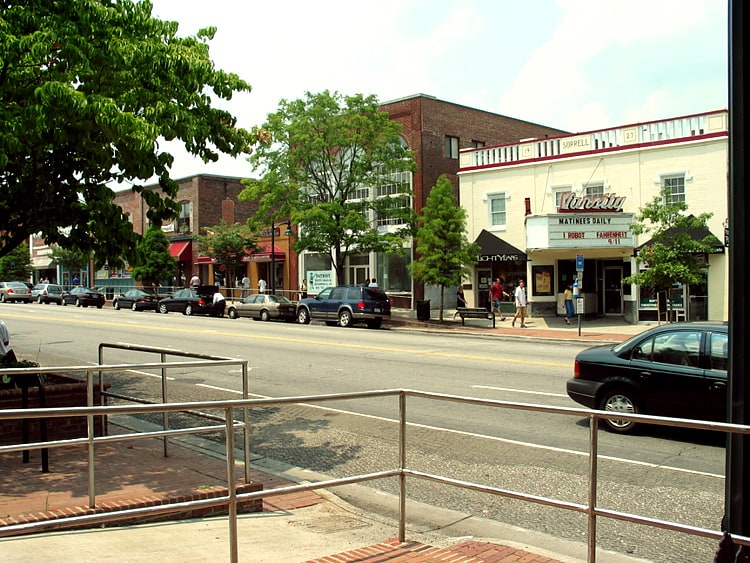
Franklin Street is a prominent thoroughfare in Chapel Hill, North Carolina. Historic Franklin Street is considered the center of social life for the University of North Carolina at Chapel Hill, as well as the town of Chapel Hill.
It is home to numerous coffee shops, restaurants, museums, bookshops, music stores and bars. The street in downtown Chapel Hill is notable for its nightlife, culture, and regular festivities. The stretch of college-oriented businesses continues west into neighboring Carrboro, where the street's name changes to Main Street. Both streets are home to small music venues, like the Cat's Cradle and the Carrboro Arts Center, which were influential in the birth of Chapel Hill rock. UNC's Morehead Planetarium and Science Center, as well as the Ackland Art Museum are also located in this area.[3]
Dean Smith Center
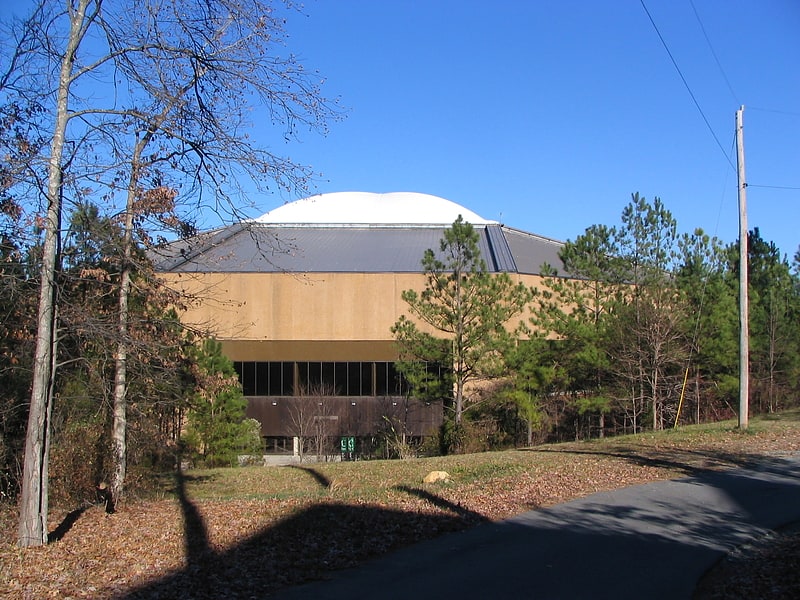
Arena in Chapel Hill, North Carolina. The Dean E. Smith Student Activities Center is a multi-purpose arena in Chapel Hill, North Carolina, used primarily as the home for the University of North Carolina at Chapel Hill Tar Heels men's basketball team. The university began to inquire about building a standalone arena for the men's basketball team beginning in the mid-1970s, but due to an ongoing university wide investigation, the fundraiser halted until its conclusion. On June 1980, the fundraising began with a goal of at least $30 million and a target completion date for the building of December 1984. It was initially planned to be called the Student Activities Center; however, after its announcement it began to be referred to as The Dean Dome and it was speculated it would be named for then coach Dean Smith. The fundraising concluded in August 1984 with over $33 million raised, but construction would not be finished until 1986. The day before the opening game on January 18, 1986, against the Duke Blue Devils, the building was officially announced to be named the Dean E. Smith Student Activities Center, while a formal dedication happen later in September. In 2018, the hardwood floor of the Smith Center was named for then coach Roy Williams.
Land was cleared in a wooded ravine on the southern part of campus and necessitated 20,000 cubic yards (15,000 m3) of rock to be dynamited out. The building is 300,000 square feet (28,000 m2) and build on 8 acres (3.2 ha) and contains three levels. There are two levels for seating, an upper and lower level, from which the furthest viewing distance is 675 feet (206 m). The Dean Dome has been renovated several times since its opening which has included the likes of new video boards, video ribbon along the upper level edge, seats, lighting, and sound. In addition, the locker rooms and office space have all been upgraded. Throughout the years the capacity has been adjusted through the removal of box seating for traditional seating and the addition of a standing student section behind one of the goals. The future of the arena is questioned due to a variety of issues stemming from a narrow concourse, limited storage, and a desire to have premium seating to earn more revenue. The issue is further complicated by the fact the Smith Center was privately funded and the seats paid for by the initial donors carry two full generations, which limits any possible renovation, but could be circumvented by building a new arena.
Through the 2018–19 season, the Tar Heels have played 33 seasons in the Dean Smith Center and have earned over 400 victories and under 100 losses. Despite their home success, the crowd has often been criticized for being dull and un–involved, which has been credited to the seating arrangement created by the above–mentioned donors which has limited the ability of the students to use the lower level and create noise. In addition to basketball, the venue has been used to host several concerts, graduations, sporting events, and a speech by Barack Obama when campaigning for the Democratic Presidential nomination.[4]
Address: Chapel Hill, 300 Skipper Bowles Drive
Kenan Memorial Stadium
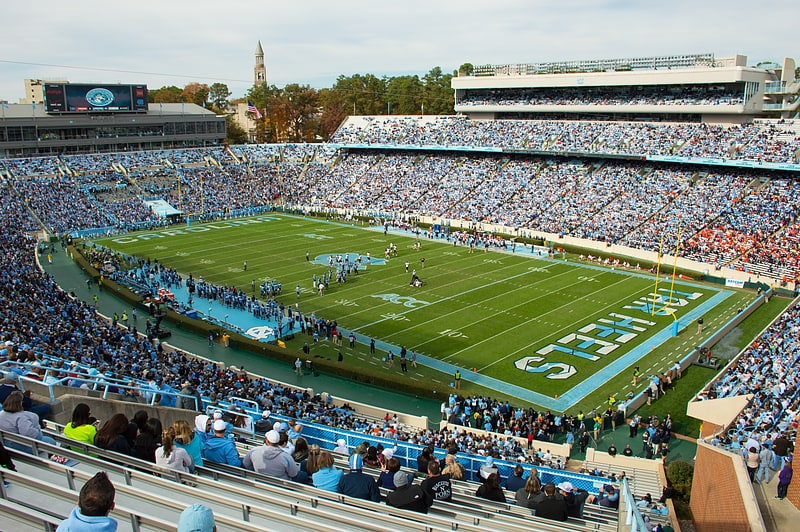
Stadium in Chapel Hill, North Carolina. Kenan Memorial Stadium is located in Chapel Hill, North Carolina and is the home field of the North Carolina Tar Heels. It is primarily used for football. The stadium opened in 1927 and holds 50,500 people. It is located near the center of campus at the University of North Carolina.[5]
Address: 104 Stadium Dr, 27514-4238 Chapel Hill
Morehead Planetarium and Science Center
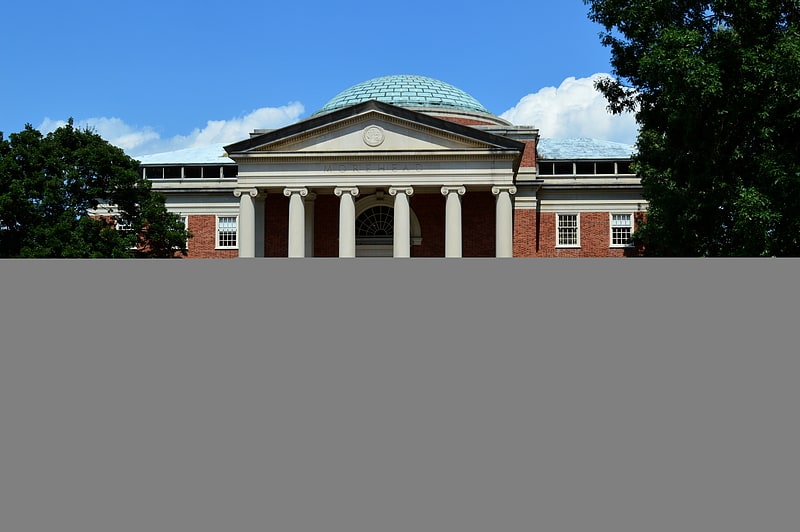
Planetarium in Chapel Hill, North Carolina. Morehead Planetarium and Science Center is located on the campus of the University of North Carolina at Chapel Hill. As a unit of the university, Morehead receives about one-third of its funding through state sources, one-third through ticket and gift sales, and one-third through gifts and grants.
First opened in 1949, the planetarium was used to train Gemini and Apollo program astronauts in celestial navigation. Until the late 1990s, it contained one of the largest working Copernican orreries in the world. The facility was donated to the university by alumnus John Motley Morehead III who invested more than $3 million in the facility.[6]
Address: 250 E Franklin St, 27514-3618 Chapel Hill
Ackland Art Museum

Museum in Chapel Hill, North Carolina. The Ackland Art Museum is a museum and academic unit of The University of North Carolina at Chapel Hill. It was founded through the bequest of William Hayes Ackland to The University of North Carolina at Chapel Hill. It is located at 101 S. Columbia Street near the intersection of Franklin Street at the northern edge of campus.
It is free of charge to visitors, and offers a wide selection of events related to exhibition, community, and university topics.[7]
Address: 101 S Columbia St, 27514-3606 Chapel Hill
North Carolina Botanical Garden
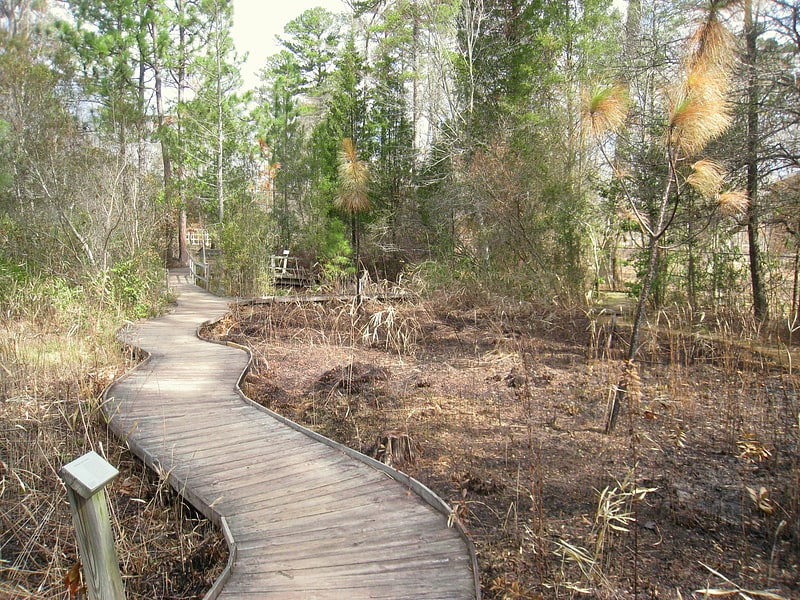
Free, natural retreat on UNC campus. The North Carolina Botanical Garden is a botanical garden operated by the University of North Carolina at Chapel Hill in Chapel Hill, North Carolina. The primary goal of the Garden is to research, catalog, and promote the native plant species of North Carolina.[8]
Address: 100 Old Mason Farm Rd, 27599-3375 Chapel Hill
Silent Sam

Statue by John A. Wilson. The Confederate Monument, University of North Carolina, commonly known as Silent Sam, is a bronze statue of a Confederate soldier by Canadian sculptor John A. Wilson, which had stood on the historic McCorkle Place of the University of North Carolina at Chapel Hill from 1913 until it was pulled down by protestors on August 20, 2018. Its former location has been described as "the front door" of the university and "a position of honor".
Establishing a Confederate monument at a Southern university became a goal of the North Carolina chapter of the United Daughters of the Confederacy (UDC) in 1907. UNC approved the group's request in 1908 and, with funding from UNC alumni, the UDC and the university, Wilson designed the statue, using a young Boston man as his model. At the unveiling on June 2, 1913, local industrialist and UNC Trustee Julian Carr gave a speech espousing white supremacy, while Governor Locke Craig, UNC President Francis Venable and members of the UDC praised the sacrifices made by students who volunteered to fight for the Confederacy. The program for the unveiling simply referred to the statue as "the Confederate Monument", with the name "Soldiers Monument" also being used around the same time. The name Silent Sam is first recorded in 1954, in the student newspaper The Daily Tar Heel.
Beginning in the 1960s, the statue faced opposition on the grounds of its racist message, and it was vandalized several times during the civil rights movement. Protests and calls to remove the monument reached a higher profile in the 2010s, and in 2018, UNC Chancellor Carol L. Folt described the monument as detrimental to the university, and said that she would have the statue removed if not prohibited by state law. Increased protests and vandalism resulted in the university spending $390,000 on security and cleaning for the statue in the 2017–18 academic year. The statue was toppled by protesters, and later that night removed to a secure location by university authorities. A statement from Chancellor Folt said the statue's original location was "a cause for division and a threat to public safety," and that she was seeking input on a plan for a "safe, legal and alternative" new location.
The UNC-Chapel Hill Board of Trustees made a recommendation in December 2018 for a new "University History and Education Center" to be built on campus, at an estimated cost of $5.3 million, but this was rejected by the university system's Board of Governors. The pedestal base and inscription plaques were removed in January 2019, with a statement from Chancellor Folt citing public safety.
In November 2019, in response to a lawsuit from the Sons of Confederate Veterans, UNC donated the statue to the group, with a $2.5 million trust for its "care and preservation", on the condition that the statue would not be displayed in the same county as any UNC school. However, in February 2020 the settlement was overturned by the judge who originally approved it, who ruled that the SCV lacked standing to bring the lawsuit.[9]
Address: E Franklin St, 27514 Chapel Hill
Boshamer Stadium
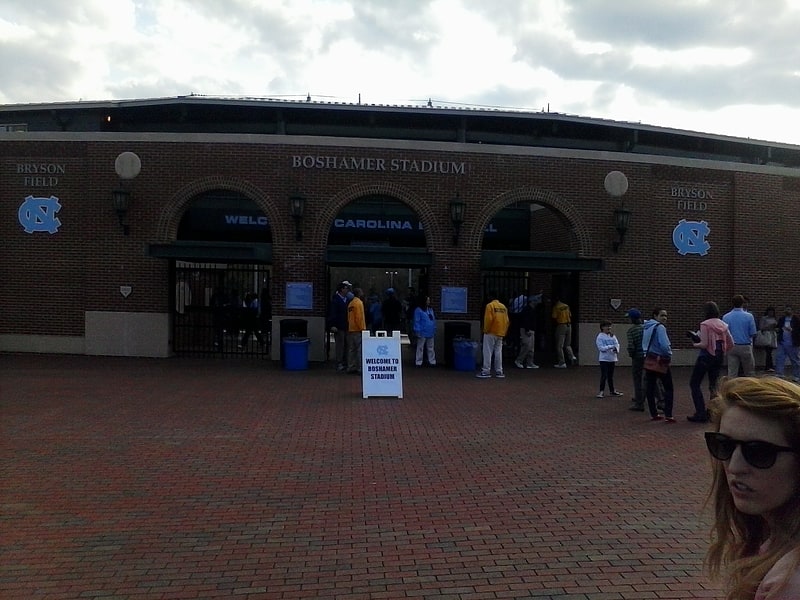
Stadium in Chapel Hill, North Carolina. Cary C. Boshamer Stadium is a baseball stadium in Chapel Hill, North Carolina. It is the home of the North Carolina Tar Heels baseball team.[10]
Address: 235 Ridge Rd, 27514-3343 Chapel Hill
Davie Poplar
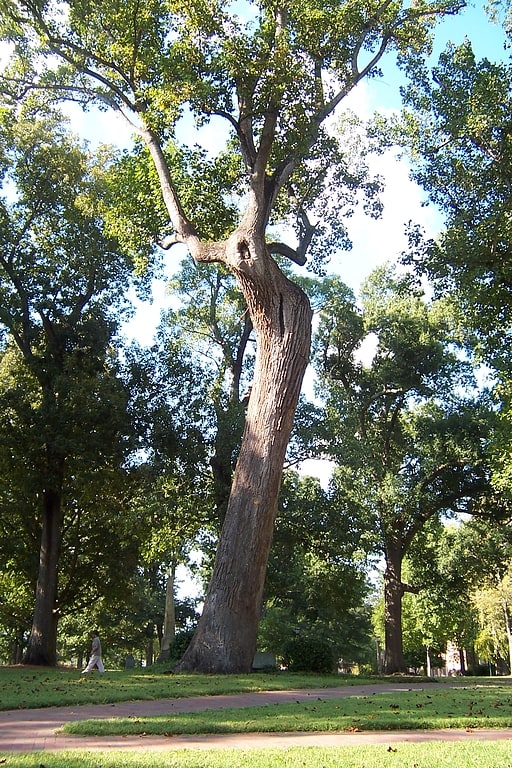
Historical landmark in Chapel Hill, North Carolina. Davie Poplar is a large tulip poplar tree located in McCorkle Place on the campus of the University of North Carolina at Chapel Hill. Named in honor of Revolutionary War general and university founder William Richardson Davie, the tree is approximately 300 to 375 years old.[11]
Coker Arboretum
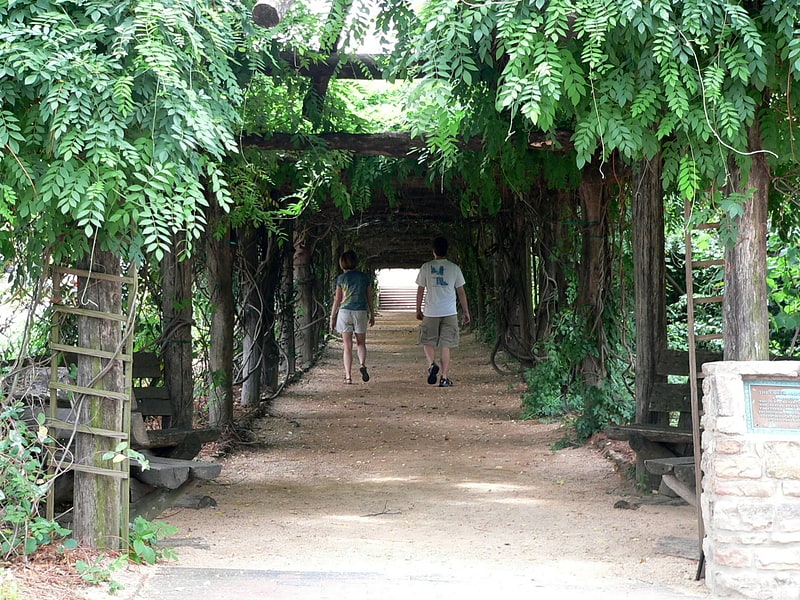
Botanical garden with varied plantings. Coker Arboretum is an arboretum within the North Carolina Botanical Garden on the campus of the University of North Carolina, Chapel Hill, North Carolina. The collection consists of a wide variety of plantings including flowering trees and shrubs as well as bulb and perennial displays. It is open daily without charge.
The arboretum was established in 1903 by Dr. William Chambers Coker, the University's first Professor of Botany and the first chair of the University Buildings and Grounds Committee. Coker loved East Asian species and added many throughout the 1920s into the 1940s, including conifers and one Metasequoia, as well as daffodils and daylilies. Two prominent features are a native vine arbor (300 feet long) and an adjacent stone circle.[12]
Address: E Cameron Ave, 27514 Chapel Hill
Morehead-Patterson Bell Tower
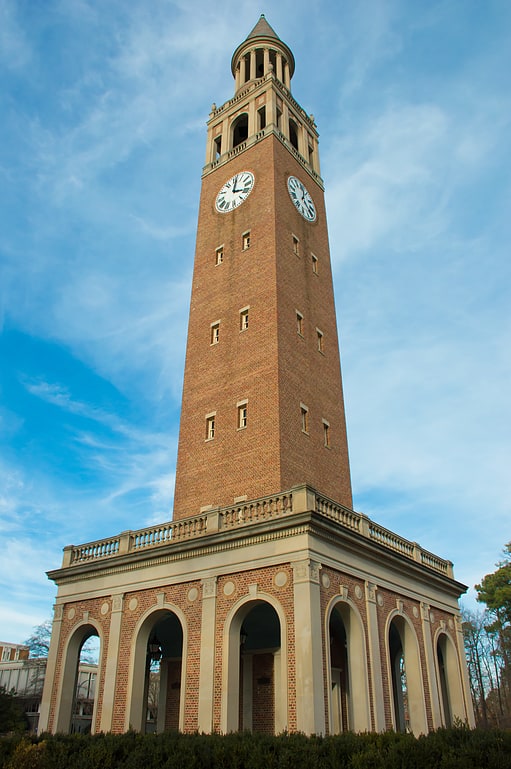
Tower in Chapel Hill, North Carolina. The Morehead-Patterson Bell Tower is a functioning bell tower located on the campus of The University of North Carolina at Chapel Hill. It is a 172-foot-tall tower with a Roman numeral clock built-in on each of the four sides of the tower. The top of the bell tower holds an observation area. It is topped by a conical spire structure. The area around the bell tower is surrounded by hedges and a grass lawn designed by University botany professor William Chambers Coker, who also designed the Coker Arboretum on campus. The tower is one of the most visible landmarks on campus.[13]
Address: South Rd, 27517 Chapel Hill
Playmakers Theatre
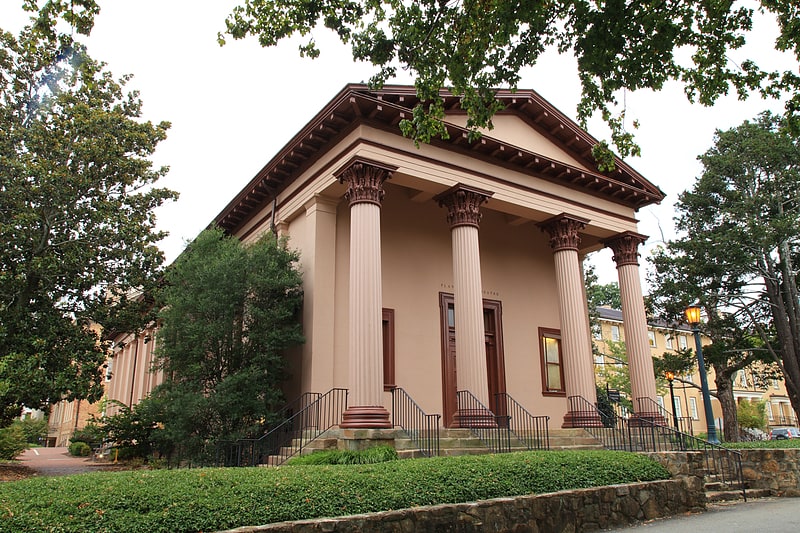
Theatre in Chapel Hill, North Carolina. The Playmakers Theatre, originally Smith Hall, is a historic academic building on the campus of the University of North Carolina at Chapel Hill. Built in 1850, it was designated a National Historic Landmark for its architecture, as an important example of Greek Revival architecture by Alexander Jackson Davis. It is now a secondary venue of the performing company, which is principally located at the Paul Green Theatre.[14]
Address: 202 E Cameron Ave, 27514 Chapel Hill
Stone Center

Art gallery in Chapel Hill, North Carolina. The Sonja Haynes Stone Center for Black Culture and History was founded on July 1, 1988 at the University of North Carolina at Chapel Hill.[15]
Old Chapel Hill Cemetery

Graveyard. Old Chapel Hill Cemetery is a graveyard and national historic district located on the campus of the University of North Carolina at Chapel Hill in Chapel Hill, North Carolina.[16]
Address: 302 Country Club Rd, 27514 Chapel Hill
Kidzu Children's Museum

Museum in Chapel Hill, North Carolina. Kidzu Children's Museum is a private, 501 non-profit children's museum serving ages infant through tween. The museum was established in 2006 in a store front on Franklin Street in Chapel Hill, North Carolina. The museum soon outgrew the location and began looking for a larger space. In November 2011, after construction delays pushed back the move to a larger space, the museum temporarily moved to University Square. Then in February 2014, Kidzu reopened in University Place in Chapel Hill. They are contracted to stay in the mall through 2017.[17]
Carolina Basketball Museum

Museum, Specialty museum, History museum
Address: 450 Skipper Bowles Dr, 27514-3433 Chapel Hill
Old Well
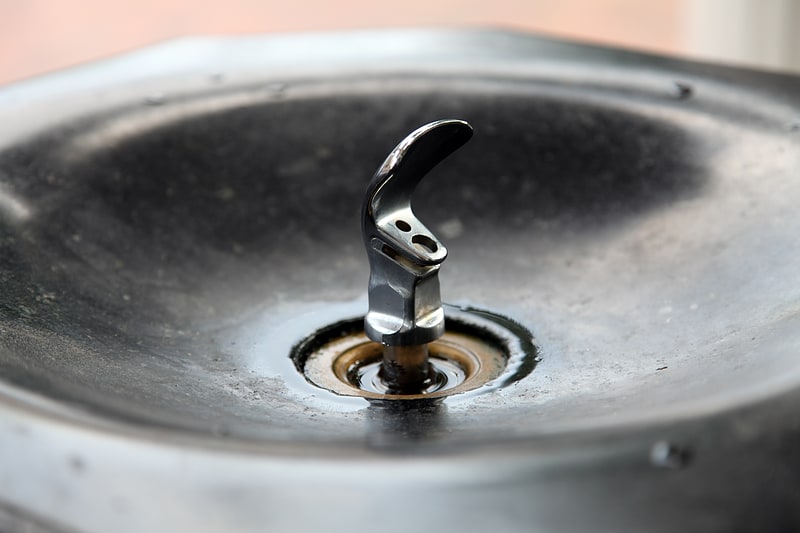
Drinking water fountain in Chapel Hill, North Carolina. The Old Well is a small, neoclassical rotunda located on the University of North Carolina at Chapel Hill campus at the southern end of McCorkle Place. The current decorative form of the Old Well was modeled after the Temple of Love in the Gardens of Versailles and was completed in 1897. It was designed by the university registrar Eugene Lewis Harris, an artist and 1881 graduate of the institution, who served as registrar from 1894 to 1901. It is the most enduring symbol of UNC.
The Old Well is located between Old East and Old West residence halls. For many years, it served as the sole water supply for the university. In 1897, the original well was replaced and given its present signature structure by university president Edwin A. Alderman. In 1954, the university built benches, brick walls, and planted various flower beds and trees around the Old Well.
Before COVID-19 restrictions due to the pandemic, passers-by could drink from a marble water fountain supplying city water that sits in the center of the Old Well. Campus tradition dictates that a drink from the Old Well on the first day of classes will bring good luck (or straight A's).
The Old Well is recognized as a National Landmark for Outstanding Landscape Architecture by the American Society of Landscape Architects. The Old Well is also used on the official stamp of all apparel licensed by the university. Because of its status as a symbol of the university, it is the target of vandals around the time of Carolina - State sporting events.
In Kinston, North Carolina, there is a replica of the Old Well, created to honor UNC alumnus Harvey Beech. Beech was one of the first African-Americans to attend the University of North Carolina School of Law.[18]
Address: 201 E Cameron Ave, 27514 Chapel Hill
Carrboro
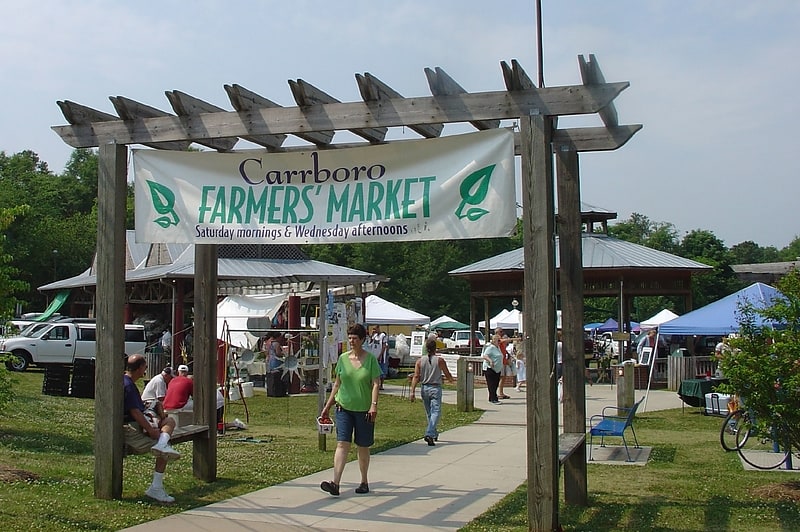
Town in North Carolina. Carrboro is a town in Orange County in the U.S. state of North Carolina. The population was 19,582 at the 2010 census. The town, which is part of the Raleigh-Durham-Chapel Hill combined statistical area, was named after North Carolina industrialist Julian Shakespeare Carr.
Located directly west of Chapel Hill, home of the University of North Carolina's flagship campus, Carrboro has a reputation as one of the most progressive communities in the Southeastern United States. It was the first municipality in North Carolina to elect an openly gay mayor (Michael R. Nelson in 1995) and the first municipality in the state to grant domestic-partner benefits to same-sex couples. In October 2002, Carrboro was among the first municipalities in the South to adopt resolutions opposing the Iraq War and the USA PATRIOT Act.[19]